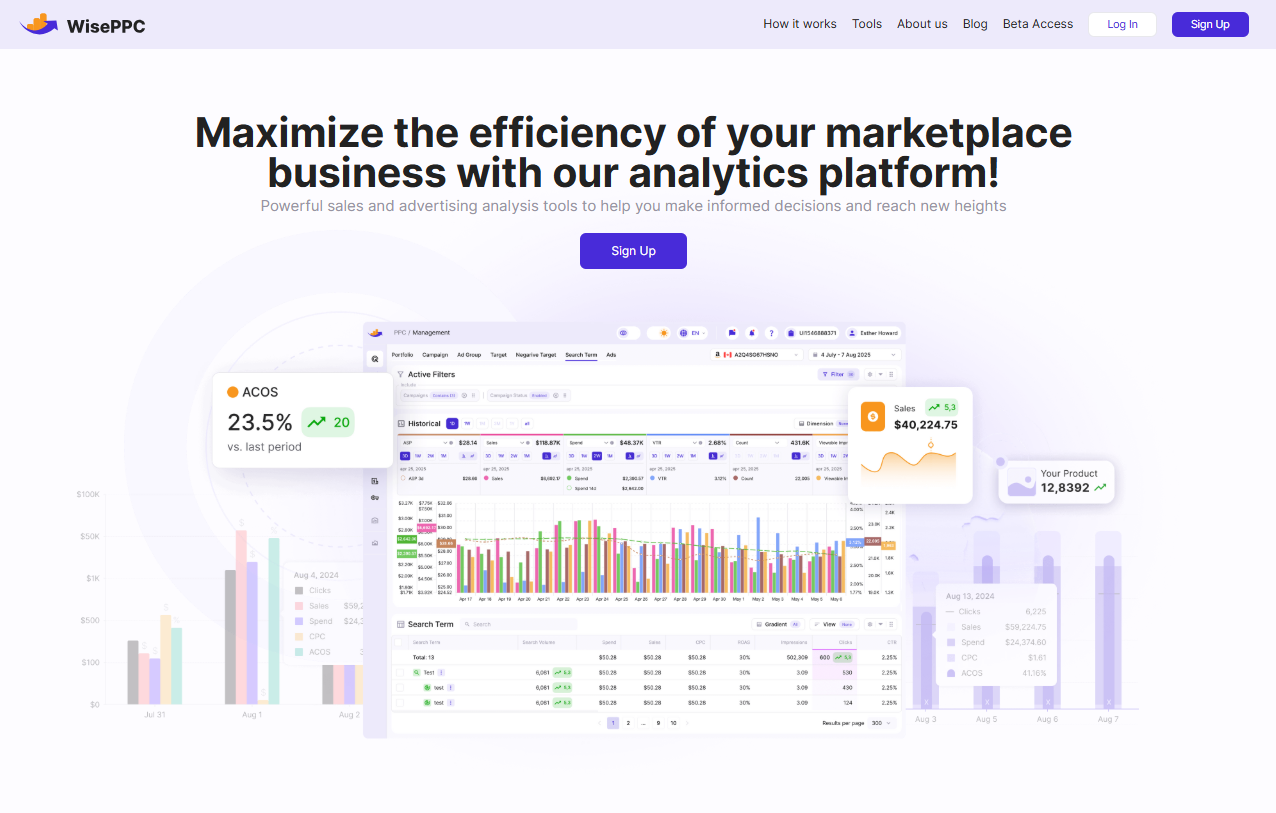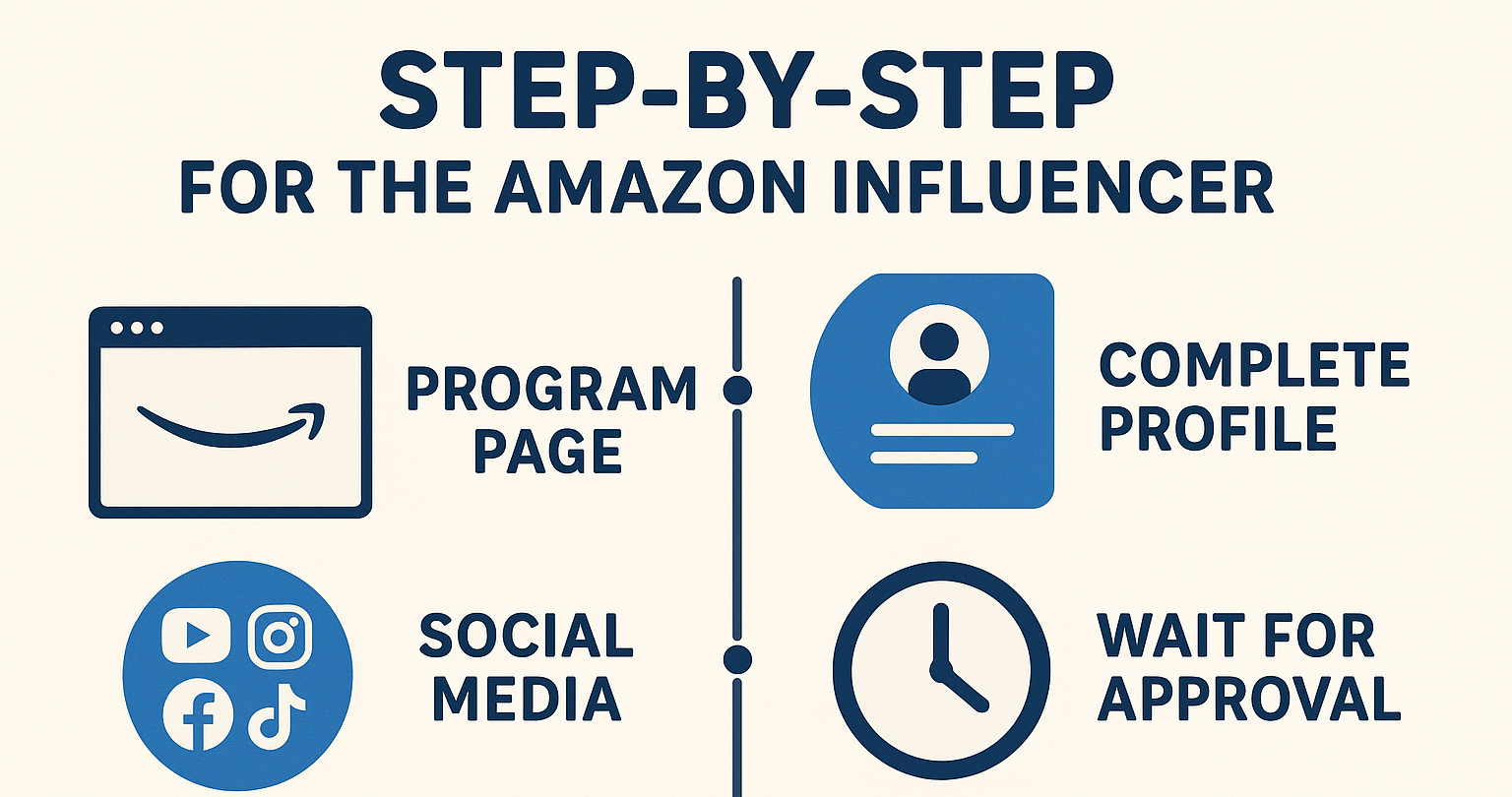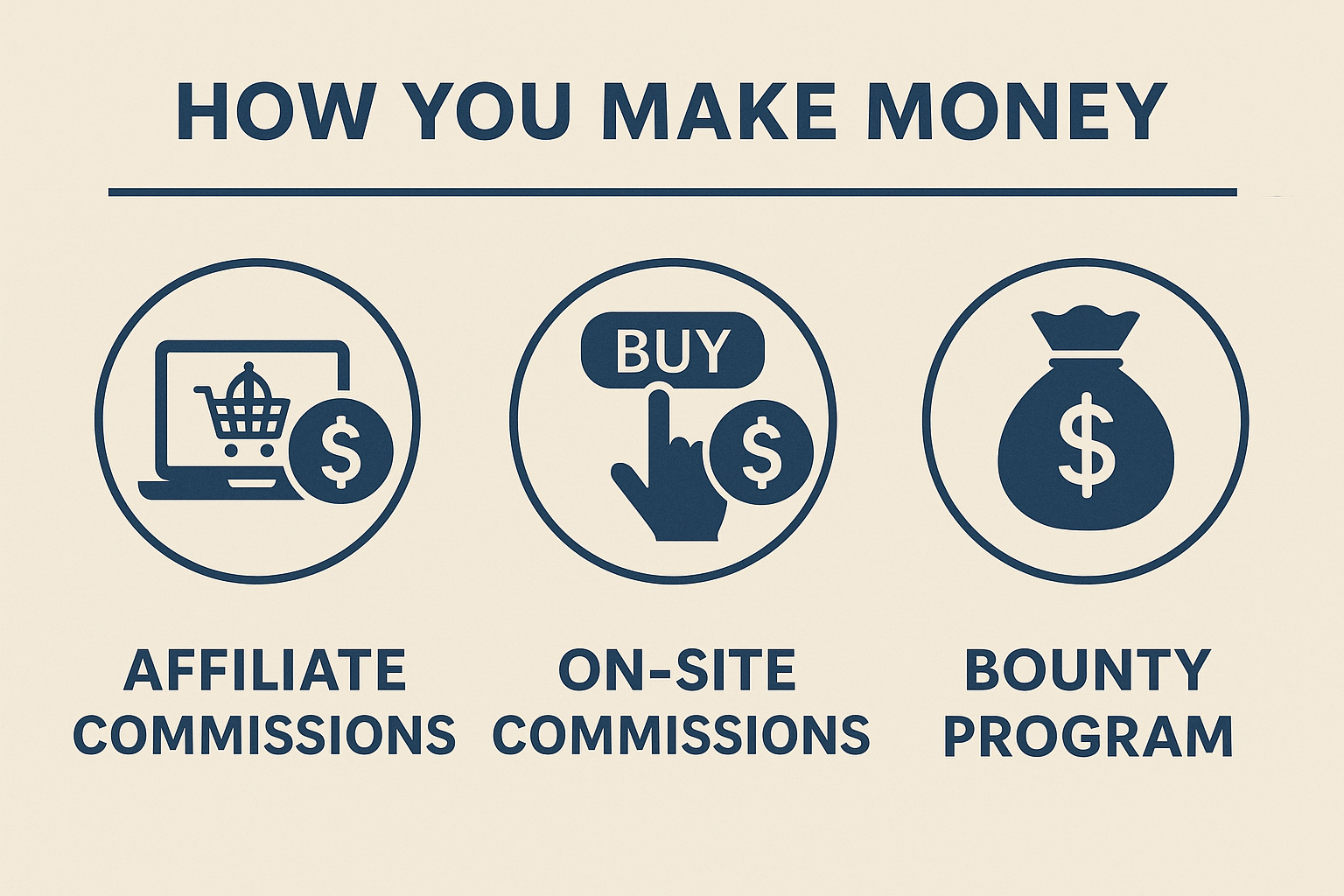Your 2025 Guide to Becoming an Amazon Influencer
A few years ago, being an “influencer” meant picture-perfect posts, massive followings, and glossy brand deals. Fast forward to 2025, and the game has changed. Thanks to the Amazon Influencer Program, you don’t need a million followers or a ring light obsession to monetize your content. If you’ve got an audience that trusts you, even a small one, you’ve already got a head start. This guide breaks down what the program is, how it actually works, and what it takes to get started. We’ll cover everything from picking the right niche to building a storefront that doesn’t feel like a garage sale. Whether you’re on TikTok, YouTube, or just figuring things out, there’s a way in. Let’s walk through it.
What Makes the Amazon Influencer Program Different?
Most people lump it in with Amazon’s affiliate program, but the Influencer Program is a separate track with a few key upgrades:
- You get a personalized Amazon storefront (URL and all) where you can organize product lists, videos, and content.
- You can earn not only off-site commissions but also on-site placements when your videos show up on Amazon product pages.
- The storefront gives you a branded, central place to send your audience, which means higher conversion rates.
This isn’t about blasting affiliate links anymore. It’s about curating a real experience that lives on Amazon’s platform.
Who Can Apply?
Amazon doesn’t publish strict follower requirements, but there are a few things that will improve your chances. First, you need a public and active presence on one of the supported platforms: YouTube, Instagram, TikTok, or Facebook. If you’re applying through Instagram or Facebook, your account should be set to Business status so Amazon can assess your data.
Consistency and quality matter more than follower count. If you regularly post engaging content that connects with your audience, that already puts you ahead. Amazon also looks for influencers with a clear niche or content theme that aligns with product promotion. Whether you focus on tech reviews, home organization, beauty, fitness, or parenting, what matters most is that your audience knows what to expect from you.
You don’t need 100,000 followers to get in. Many successful applicants have between 1,000 and 10,000 followers. What matters more is engagement. If your followers are consistently liking, commenting, sharing, and interacting with your content, Amazon sees that as a sign that your recommendations carry weight.
At the end of the day, Amazon wants creators who can communicate authentically. They’re not just looking for influencers chasing numbers. If your audience trusts you, and you consistently create helpful, entertaining, or informative content, you have a strong shot. In many cases, a smaller, engaged community is more valuable than a large but inactive following.

How WisePPC Can Help You Succeed as an Amazon Influencer
We built WisePPC to simplify and scale your marketplace growth, and yes, that includes creators like you. If you’re part of the Amazon Influencer Program, your storefront is just the beginning. What happens next depends on the content you produce, the products you choose, and how well you understand performance over time. That’s where we come in.

How WisePPC Helps Influencers Get Real Results:
- Track what products actually drive traffic and sales using performance-backed analytics
- Discover new high-potential items with low competition and high demand using our advanced filters
- Spot underperforming campaigns or targets before they cost you ad spend
- Optimize your ad performance with insights from real-time and long-term data
- Manage ad campaigns alongside other marketplace activity
- Understand ad-driven vs. organic impact, so you can tailor your ad strategy accordingly
Because we’re an Amazon Ads Verified Partner, we use official integrations and best practices to ensure what you’re seeing is accurate, actionable, and aligned with your goals. Whether you’re reviewing products weekly or managing a hybrid brand-influencer account, WisePPC gives you the control and visibility to make smarter choices, and grow faster.
Step-by-Step: How to Apply for the Amazon Influencer Program
The application process for the Amazon Influencer Program is surprisingly straightforward, but you’ll want to approach it with some strategy.
1. Visit the Program Page
Start by heading to the official Amazon Influencer Program page and sign in with your existing Amazon account. If you don’t have one yet, you’ll need to create it first.
2. Connect Your Best Social Media Account
Once logged in, Amazon will prompt you to connect one of your social media accounts. Choose the one with the highest engagement and most consistent content, this is what Amazon will evaluate to decide if you’re a good fit.
3. Complete Your Profile
After linking your account, you’ll be asked to complete a basic profile. This includes uploading a profile picture, writing a short bio, and choosing a display name. Make sure your bio reflects your brand and the kind of content you create. If you already have a niche, mention it. The goal is to show Amazon that you know who you are and who your audience is.
4. Submit and Wait for Approval
Once your profile is filled out, it’s time to submit. For some applicants, approval is instant. For others, it may take a few days as Amazon reviews the engagement levels and overall fit of your account.
5. What If You’re Not Approved?
If you don’t get approved the first time, don’t sweat it. It’s not a hard no forever. Many influencers have been accepted on their second or even third try. Use the time to refine your content, grow your audience, and increase your engagement. When you feel ready, simply reapply.
Remember, the application is your first impression. Treat it like you would a brand collaboration, polished, intentional, and true to what makes your content stand out.
Setting Up Your Storefront
Once you’re accepted, you’ll get a unique URL for your Amazon storefront. This becomes your personal space on Amazon’s platform, a place where followers can browse all the products you recommend. Think of it as your own digital retail hub. The more polished and branded it feels, the better the user experience for your audience.
Here’s how to set it up:
- Upload your branding assets: Start with a high-quality profile photo and a banner image that matches your branding from platforms like Instagram or YouTube.
- Write a short bio: Tell visitors who you are, what niche you focus on, and what they can expect from your recommendations. Keep it friendly and in your own voice.
- Create your first Idea Lists: Group your product picks into themed collections like:
- Everyday Beauty Products You’ll Actually Use
- Kitchen Tools I Swear By
- Travel Must-Haves for Long Flights
- My Favorite Tech for Content Creators
- Add video content or shoppable images: Record short clips showing how you use certain products in daily life. These can be uploaded even if you don’t stream live.
- Organize the layout: Use the tools available to feature your best content front and center. Keep the design clean and intuitive.
When done right, your storefront becomes more than just a product list. It’s a trust-building space that encourages your audience to return, engage, and buy.
How You Make Money
Amazon Influencers have a few different revenue streams built into the program. While it’s not a get-rich-quick situation, consistent effort and smart promotion can build meaningful income over time.
- Affiliate Commissions: This is the most common way influencers earn. You share your storefront or direct product links, and every time someone makes a purchase through those links, you get a percentage. The rates vary by category, but it’s passive income that adds up over time.
- On-Site Commissions: This one’s interesting. When you upload product videos and Amazon places them on relevant product pages, you get paid if a viewer watches your video and then buys the product. This means even if someone didn’t click your direct link, your content can still drive earnings.
- Bounty Program: Amazon also runs special bounty offers where you can earn fixed payouts for getting people to sign up for services like Audible, Kindle Unlimited, or Amazon Prime. These aren’t tied to physical product sales and can be a smart way to diversify your earnings.
Keep in mind, Amazon has a 60-day payout window after the month of the sale, so there’s a delay before the money hits your account. Also, canceled or returned items won’t count toward your commissions.
The key here is patience and consistency. The more quality content you produce, the more visibility you get, and the more likely you are to generate a steady income stream.
Using Social Media to Drive Traffic to Your Storefront
Your Amazon storefront won’t promote itself. Social media is where the real traction begins, and how you use it makes all the difference. You don’t need to be everywhere, but you do need to be intentional about how you use the platforms where your audience already hangs out.
Start by choosing one or two platforms where you’re already active and have the most engagement. For many creators, that’s Instagram, TikTok, or YouTube. Each one works differently:
- Instagram: Ideal for curated visuals, reels, stories, and product roundups. Use link-in-bio tools like Linktree or direct Amazon storefront links in your story highlights.
- TikTok: Thrives on quick, authentic product demos. Short videos showing how something actually works tend to get more traction than polished ads.
- YouTube: Great for longer-form content like tutorials, comparisons, or unboxings. Add your storefront or affiliate links in the video description and mention them in the video itself.
- Facebook: Works well for creators with active groups or pages. You can also post your Idea Lists and link them in your posts.
The key is to integrate your recommendations naturally into your content. Here’s what that looks like:
- Share real experiences. Post about how you use the product in your everyday life.
- Stay in your niche. Keep your content aligned with your brand, whether that’s fitness, home decor, parenting, or tech.
- Use storytelling. Don’t just say “this is a good product” – explain how it solved a problem or why you love it.
- Be clear about your links. Let people know where to find what you’re talking about and why you’re sharing it.
Also, don’t underestimate the power of repurposing. One product demo can be a TikTok, an Instagram Reel, a YouTube Short, and a pinned post on Facebook, all leading traffic back to your Amazon storefront.
Social platforms are where people connect with you. Amazon is where they convert. Use both together, and you’ll start to see real momentum.
Long-Term Success as an Amazon Influencer: What Works and What Doesn’t
Becoming an Amazon Influencer is exciting, but staying one? That takes strategy, patience, and consistency. It’s not about going viral overnight or getting lucky with a single product. The people who do well long term are the ones who treat it like a real business. Here’s what helps you grow sustainably, and what can quietly hold you back.
What Actually Works
- Stay consistent: Showing up regularly matters more than perfection. Whether it’s one post a week or three, set a pace you can stick to and keep delivering. This helps your audience know what to expect and keeps your storefront active in Amazon’s algorithm.
- Keep things fresh: Products trend, seasons change, and what your audience wants today may shift tomorrow. Revisit your storefront monthly. Swap out underperforming items, add new finds, and update titles or descriptions to reflect the current season or audience needs.
- Engage like a real person: This isn’t just about links. Reply to comments. Ask questions. Use polls and stories to involve your audience in product selection. When people feel included, they’re more likely to trust your recommendations and come back for more.
- Be upfront about commissions: Transparency builds credibility. A simple line like “I earn commissions from these links” goes a long way. It shows you respect your audience and builds trust over time.
- Track what works and double down: Use Amazon’s influencer analytics or a third-party tool to see what’s converting. If a certain product or video is performing well, figure out why, then replicate that formula.
Mistakes That Kill Momentum
- Promoting random products without a clear tie-in: If your audience follows you for skincare and suddenly sees you pitching power tools, it’s confusing. Stay within your niche or, at the very least, explain why the product matters to you.
- Neglecting your storefront layout: A cluttered, unorganized page makes it harder for shoppers to browse. Keep categories clear, use good thumbnails, and group similar products together. Think like a shopper, would you stay on a page that looks like a mess?
- Pushing too hard, too often: Nobody wants to feel like they’re being sold to 24/7. Mix in value-based content like how-to videos, comparison clips, or personal stories. Make it feel less like an ad and more like a recommendation from a friend.
- Not measuring performance: If you’re not tracking what actually earns clicks or sales, you’re flying blind. Metrics help you refine your strategy instead of guessing what your audience wants.
- Expecting fast results Growth often starts slow, and that’s normal. Most successful influencers spend months building their presence before seeing steady income. Give it time and keep showing up.
Final Thoughts
Being an Amazon Influencer in 2025 is no longer reserved for social media stars with six-figure followings. If you create thoughtful content, speak to a clear audience, and stay consistent, it’s a legit way to monetize what you’re already doing online.
You don’t need to go full-time right away. Start small. Test a few product collections. Share content that feels natural. And as your storefront and audience grow, the income can follow.
It’s not flashy or instant, but if you’re in it for the long run, this is one of the simplest ways to turn influence into income.
FAQ
Do I need a huge following to get accepted?
No, you don’t need to be internet-famous. Many influencers with as few as 1,000 engaged followers have been accepted. Amazon is more interested in consistent content and a clear niche than massive numbers.
Which social media platforms are supported?
Amazon currently supports YouTube, Instagram (business account required), TikTok, and Facebook (also business account). You can apply using your strongest, most active account.
How long does the approval process take?
Some creators are approved instantly. Others may wait a few days. If you’re not approved right away, you can reapply later after improving your social presence or engagement.
What kind of content should I post?
Focus on authentic product recommendations that match your niche. Reviews, unboxings, tutorials, and “favorites” lists tend to perform well. The goal is to be helpful, not pushy.
How do I earn money from this?
You earn commissions when people purchase products through your links or storefront. You can also earn from video views on Amazon product pages and fixed bounties for Amazon services (like Audible signups).
Is there a cost to join the Influencer Program?
Nope. It’s free to apply and participate. Your earnings come from commissions and bounties, not from upfront fees.
What tools can help me grow faster?
Analytics tools like WisePPC can help track performance, find winning products, and improve your strategy over time. Using data instead of guesswork gives you a serious edge.
Join the WisePPC Beta and Get Exclusive Access Benefits
WisePPC is now in beta — and we’re inviting a limited number of early users to join. As a beta tester, you'll get free access, lifetime perks, and a chance to help shape the product — from an Amazon Ads Verified Partner you can trust.
 No credit card required
No credit card required
 Free in beta and free extra month free after release
Free in beta and free extra month free after release
 25% off for life — limited beta offer
25% off for life — limited beta offer
 Access metrics Amazon Ads won’t show you
Access metrics Amazon Ads won’t show you
 Be part of shaping the product with your feedback
Be part of shaping the product with your feedback





